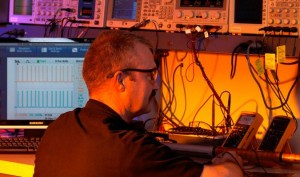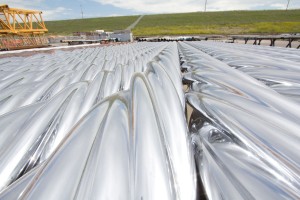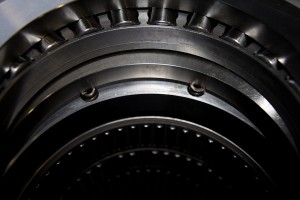It’s a world of “chasing gamma” “lost circulation zones,” and drillbit steering. The downhole technology that has everyone talking is one that is constantly seeing new refinements. These professionals share some of the latest developments in Measurement While Drilling practices.
By Al Pickett, Special Contributor
There has been a paradigm shift in the Permian Basin, and with it has come a number of changes. Trey Garmon, account manager for Phoenix Technology Services, pointed out that in the Permian Basin, where even as recently as a few years ago there was still an emphasis on vertical drilling (made all the more effective by the commingling of zones in the development of the Wolfberry play), we are seeing a transition to a basin dominated by horizontal drilling.
“The rig count in the Permian Basin six months ago was 60 to 65 percent horizontal,” he said. “Now, with the current downturn, it is 75 percent horizontal. There are 10 different prospective formations for horizontal drilling.”
Phoenix Technology Services is a global directional drilling service provider that was founded 20 years ago and which has had an operations facility in Midland for more than three years.
The advent of horizontal drilling in the Permian Basin has also brought a new technology known as Measurement While Drilling, better known as MWD, to the region. It was first used in over 30 years ago in offshore drilling and is now a requirement when drilling horizontal or directional lateral well onshore.
Steve Johnson, regional manager for Leam Drilling Systems, LLC, in Midland, said the use of directional or horizontal drilling seemingly changed overnight.
“I started directional drilling in 1993,” Johnson reflected. “It was new then, and it was usually out of necessity because you were drilling under a house or a highway.”
Johnson said that when operators figured out that the horizontal wells were making five times as much production, the industry began to move to horizontal drilling to exploit the unconventional shale plays. Horizontal drilling actually started in the Austin Chalk in central Texas and was then popularized in the gas wells in the Barnett Shale in the Fort Worth Basin, according to Johnson.
He said operators now have to put the pencil to it to determine if they want to drill one horizontal well that can cost two-and-a-half times the price of a vertical well or if they want to pay to drill three vertical wells in place of the lateral, which could result in fewer barrels of oil per day than drilling horizontally.
The Wolfcamp Shale in Glasscock County, Upton, Reagan, and Howard counties, as well as other neighboring counties in the Midland Basin, and the Bone Spring formation in far West Texas and Lea and Eddy counties in New Mexico are attracting much of the horizontal drilling activity in the Permian Basin presently, according to Johnson.
“MWD equipment, which sits about 40 to 50 feet behind the drill bit, provides downhole measurements that indicate the location of the drill string, allowing the driller to stay on a predetermined plan,” Garmon explained.
That is not as easy as it sounds. Garmon said the directional driller is often drilling a 7,000 to- 8,000-foot lateral and trying to “steer the bit to a small, narrowly defined target.”
He pointed out that there are two types of MWD systems—a mud pulse MWD tool, which is most common tool used in the Permian Basin, and an electromagnetic (EM) MWD tool that is less common. The EM tool utilizes an electric signal while down hole to transmit data to an antenna on the surface.
The mud pulse MWD tool sends data viaa pulse through the drilling mud to the surface where a computer decodes it. The information provided by an MWD tool allows the driller to effectively determine if, and when, he needs to adjust the drilling parameters to keep the drill bit on the pre-determined path.
“If the [MWD] tool is not working, drilling cannot proceed, as the driller has no way of determining where he is steering without the data that the MWD tool provides,” Garmon stated. “With operators spending sometimes more than $60,000 per day for a drilling rig to operate, it is all about performance.”
The Plan
So what happens when an operating company decides to drill a horizontal well and wants to use MWD?
“The operator calls us,” explained Leam Drilling Systems’ Johnson. “Let’s say they plan to drill a well in Reeves County with a true vertical depth (TVD) target of 11,000 feet. They call our well-planning department, and we plan a best-case scenario. If they are starting the horizontal lateral at 11,000 feet, we will start building the angle at, say, 10,200 feet. When we get our plan, we will send it to the operator on paper.”
In addition to providing Leam Drilling with the TVD target, the operator also gives the directional company the proposed lateral length, which Johnson maintained is derived from the plat with the lease lines.
Once the plan has been approved, Johnson said, it is turned over to the MWD and directional tool coordinators, who set up the equipment and determines what motors and MWD tool lines will be most effective and applicable in drilling the well to plan.
Brandon Hall, the MWD coordinator with Leam, said he supervises the regional logistics, field staff, and customer requests for the MWD department.
“I’m the first point of contact for our field engineers and clients when additional equipment, knowledge, or services are needed,” Hall said. “Our real-time operations center (RTOC) is responsible for monitoring operations on the well site. RTOC is a remote-monitoring command center where we can remotely record and distribute surveys, logs, and anti-collision reports, and can monitor MWD data and drilling conditions live. The recent developments in our technology is proving to be a huge cost saver for customers. We have well trained and experienced professionals monitoring our wells around the clock. This centralized command center continues to dramatically increase our knowledge base and our efficiency is delivering a great product to our customers. If something goes wrong, we have experts with decades of combined experience at our disposal to assist in reacting to any situation. Things can change in an instant while drilling, due to formation, plan changes, or equipment damaging or wearing. Leam’s job is to prepare for the unexpected and respond quickly and strategically.”
Hall contended that many operators are “actively making changes to TVD, according to the MWD’s telemetered gamma.”
“A single formation should yield steady gamma ray counts,” he said. “Therefore, if an operator or geologist sees that gamma is increasing or decreasing at a questionable rate, indicating that perhaps the drill string has begun transitioning into an undesired formation, changes may be made to ensure that the wellbore remains in the ‘pay zone’ in conjunction with the gamma. The geo-steerers, geologist, and drilling engineers decide if thewell is going as planned. When it’s not, we adjust accordingly and get it back on track.”
Some professionals in this line of work refer to these tactics as “chasing gamma.”
Hall said that the overall goal for all parties involved is to adapt to any changes and keep the bit on bottom and on target.
Even with the use of MWD, Johnson said, the well “can throw us obstacles: fault lines, unexpected formation changes, or lost circulation zones. The formation might be ‘pushing’ the hole to the right harder than expected, when you need it to go left.”
According to Hall, “Most MWD tools tell you where you are, not necessarily where you are going, since they are usually 40-plus feet behind the bit. We can project the wellbore direction to the bit, but if you get off target, you have to make adjustments.
Added Johnson: “All the information is based off of MWD, from the inclination to the azimuth. Everything the directional driller does is based off MWD.”
Hall remarked: “The MWD engineers are the co-pilots [navigators] and the directional drillers are the pilots. They [directional drillers] use the information derived from the MWD tool to recognize and predict what the wellbore is doing so that they may steer the wellbore in the planned direction.
“There are three types of direction when planning to navigate a well: magnetic, true, and grid. Most well plans are drawn to grid north. The MWD tool reads magnetics. This being the case, a correction factor must be applied to the MWD tool in order to correct direction from magnetic to grid. Once the MWD tool is programmed, picked up, and placed downhole, there is an assortment of logging and measurement data sets that can be received from the tool either using mud pulse telemetry or electro-magnetics.”
There are other potential downhole problems, such unexpected as lost circulation zones and the pumping of lost circulation material (LCM) that could impede the MWD tools’ signals, according to Hall.
“You might be pumping 400 gallons a minute, but you are only getting 300 gallons per minute back,” he said. “That means you are losing mud into the formation. LCM helps to fill in the porous formations.”
If that happens, Hall said, “the company man will confer with the drilling engineer or mud engineer in order to find the proper application of LCM, whether it be cedar fiber, walnut hull, or even paper. Sometimes the required amounts of LCM will require a different type of MWD tool. We have different MWD tools for different applications. If we know we will encounter lost circulation zones, we will recommend our high LCM pulser, collar-mounted rotary pulser, or our electro-magnetic [EM] tool, depending on the amounts of LCM that will be pumped downhole. It depends on what services are important to the customer, as each tool line varies in features and capabilities. Communication and working together as a team, by all parties involved, is key to drilling a successful oil well.”
The Future
While continuous enhancements to MWD technology have enabled remarkable advancement in the efficiency of horizontal drilling, Garmon said many companies, including Phoenix Technology Services, are working the industry is working on other new technologies, such as advanced measurement platforms. Advanced measurement platforms provide better information, and are generally placed closer to the bit, allowing for more accurate estimates of the direction of drilling.
While horizontal drilling and hydraulic fracturing may have revolutionized the oil and gas industry in the past 10 years, it is the technological advancement of Measurement While Drilling systems that has made horizontal and directional drilling so successful.
Al Pickett is a freelance writer in Abilene and author of four books. He also owns the West Central Texas Oil Activity Index, a daily and weekly oil and gas reporting service. For more information, email apickett@sbcglobal.net.












